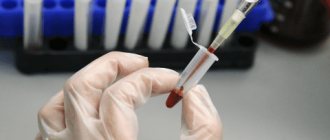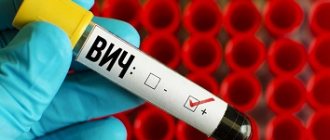You can take a blood test for antibodies to the hepatitis B virus at the nearest INVITRO medical office. A list of offices where biomaterial is accepted for laboratory research is presented in the “Addresses” section. Interpretation of study results contains information for the attending physician and is not a diagnosis. The information in this section should not be used for self-diagnosis or self-treatment. The doctor makes an accurate diagnosis using both the results of this examination and the necessary information from other sources: medical history, results of other examinations, etc.
Detailed description of the study
Hepatitis B (HBV infection) is an infectious disease that primarily affects the liver. The cause of the disease is the DNA-containing hepatitis B virus (HBV or HBV) from the Hepadnaviridae family. This hepatitis can occur in both acute and chronic forms.
The main ways the virus enters the body are divided into natural and artificial. The first group includes: sexual transmission, vertical - from a pregnant infected mother - and domestic transmission. Artificial ones include medical ones - through blood transfusions, poor-quality sterilization of instruments - and non-medical ones - any manipulations without proper sterilization: tattoos, shaving, etc.
HBV is highly resistant to environmental factors. For example, the hepatitis B virus can remain viable for months at room temperature on medical equipment that has been in contact with blood. It can also be detected in blood or blood products for several years. Therefore, all potential donors are subject to careful testing for markers of hepatitis B: there is a high risk of infecting the recipient - the person who will receive donor blood.
The most dangerous biological material for infection is the patient’s blood, less contagious (infectious): saliva, ejaculate and urine. To become infected with hepatitis B, a drop of blood—about one ten-thousandth of a liter—and microtrauma is enough. This is one of the main differences between HBV and the hepatitis C virus, which requires a much larger amount of virus in body fluids to become infected.
Like other viral hepatitis, HBV infection proceeds through incubation, pre-icteric and icteric periods. If the body copes with inflammation and the viral load, then the infection ends with a period of recovery. If not, the process becomes chronic. The incubation period averages 80 days - during this period the patient, as a rule, does not know about his illness, but is already contagious to others. The pre-icteric period is also dangerous because the clinical picture can be varied and disguised as other diseases: weakness, fever, joint pain, nausea, vomiting and diarrhea, as well as allergic rashes.
The period of jaundice, in addition to yellowing of the skin and/or sclera, is also often accompanied by a deterioration in the patient’s condition - weakness increases, appetite decreases, dizziness and headache appear, and skin itching increases. This period can last from several days to months, on average 2-6 weeks. However, in some patients, HBV infection can occur without jaundice.
Several methods are used in the laboratory diagnosis of hepatitis B. PCR allows you to detect viral DNA particles in the blood. In addition to PCR, serological research methods are used, that is, based on the “antigen + antibody” reaction. HBV contains three main antigens (particles) important for diagnosing the disease:
- Superficial (HBsAg);
- Core (HBcoreAg);
- Infectivity antigen (HBeAg).
These antigens are used as markers of HBV infection in qualitative and quantitative tests. They are examined to determine the presence and activity of the disease.
Antibodies to HBcoreAg of the IgM class are produced at the end of the incubation period (after the HBs antigen) and circulate in the blood during the clinical manifestation of HBV infection. Then, after 4-6 months, antibodies to HBcoreAg of the IgM class are replaced by IgG - these are immunoglobulins with the longest period of circulation in the blood. They can persist in a recovered person until the end of his life.
The Anti-HBV cor test in the blood allows you to evaluate the presence of IgM and IgG class antibodies in total. It is used to diagnose current hepatitis B, determining the stage of the disease (acute/chronic infection) in conjunction with other markers.
Hepatitis B markers (HBeAg, anti-HBcoreM, anti-HBe, Anti-HBcore)
Hepatitis B is an acute or chronic liver disease caused by the hepatitis B virus (HBV), occurring in various clinical forms: from asymptomatic forms to malignant ones (liver cirrhosis, hepatocellular carcinoma). Hepatitis B accounts for about 15% of all acute hepatitis registered in the Russian Federation and at least 50% of chronic hepatitis.
The structure of the hepatitis B viral particle can be schematically depicted as follows:
Fig.1. Structure of the hepatitis B virus.
Hepatitis B viral particles measuring 42 - 45 nm (Dane particles) have a rather complex structure and include DNA, DNA polymerase and antigens: surface (HBs Ag), core - nuclear or core (HBc Ag or cor Ag), infectivity antigen (HBe Ag detected in the blood during active replication of HBV infection.
The outer shell protein of HBV is its surface antigen – HBsAg. HBsAg is the main marker of hepatitis B. In acute hepatitis, HBsAg can be detected in the blood of subjects already during the incubation period in the first 4–6 weeks from the beginning of the clinical period. The presence of HBsAg for more than 6 months is considered a factor in the transition of the disease to the chronic stage.
It should be noted that only part of the HBsAg produced during virus reproduction is used to build new viral particles, while the main amount enters the blood of infected individuals, where the HBsAg antigen is determined.
HBc antigen is a core antigen, detected only in the nuclei of liver cells - hepatocytes, but absent in the blood. The determination of class M antibodies to it in the blood - antiHBc-IgM - is of great diagnostic importance. In acute hepatitis, these antibodies are detected earlier than antibodies to other viral antigens. Anti-HBc-IgM is detected in 100% of patients with acute hepatitis B. Anti-HBc total (M+G) antibodies may be the only marker of the hepatitis B virus during the “window” phase, when neither HBs-antigen nor antibodies to it can be detected in the blood. That is why they are determined at blood transfusion stations when testing donor blood and plasma.
HBeAg is a modified HBcoreAg. HBcoreAg and HBeAg are structurally related and have common epitopes—binding sites.
This is the fourth marker of active viral replication along with DNA, HBs Ag and anti-HBc –IgM.
HBe Ag is an infectivity antigen that circulates only in the presence of HBs antigen. The duration of HBe antigen circulation is an important prognostic sign. Its detection two months after the onset of the disease is a sign of the probable development of chronic hepatitis. In most cases, a change (seroconversion) of HBe Ag to anti-HBe antibodies occurs, which is a marker of completed replication of the hepatitis B virus and a prognostically favorable sign. At an early stage of seroconversion, both of these markers can be detected simultaneously.
The disappearance of HBeAg and the rapid increase in anti-HBe titer in the patient practically eliminates the threat of chronic hepatitis B. The absence of such dynamics and the detection of monotonically low concentrations of anti-HBe, on the contrary, may indicate the development of chronic hepatitis B with low activity (HBeAg-negative chronic hepatitis B).
anti-HBs are determined to assess the course of the infectious process and the favorable outcome. The fact of the appearance of anti-HBs is considered as a reliable criterion for the development of post-infectious immunity, i.e. recovery from hepatitis B. Although in chronic hepatitis B, HBsAg and anti-HBs can sometimes be detected simultaneously.
The period in which both HBsAg and anti-HBs are absent is called the serological window phase . The timing of the appearance of anti-HBs depends on the characteristics of the patient’s immunological status. The duration of the “window” phase is often 3–4 months. with fluctuations up to a year.
Anti-HBs may persist for life. Anti-HBs have protective (protective) properties. This fact underlies vaccine prevention. Currently, recombinant HBsAg preparations are mainly used as a vaccine against hepatitis B. The effectiveness of immunization is assessed by the concentration of antibodies to HBsAg in vaccinated individuals. According to WHO, the generally accepted criterion for successful vaccination is an antibody concentration exceeding 10 mIU/ml.
An important diagnostic value for determining the prognosis and treatment tactics for patients with hepatitis B is the identification of two qualitatively different phases of HBV development - replicative and integrative.
During the replicative phase (i.e., mass reproduction of the virus), replication of HBV DNA and all proteins is observed, and accordingly, antigens are copied in large quantities. Characteristic detection of HBV DNA, HBe Ag and (or) anti-HBc - IgM, HBs Ag
During the integrative phase of development (i.e., when viral particles do not undergo further replication), the HBV genome is integrated into the genome of the hepatocyte. The main role is played by the fragment carrying the gene encoding the HBs antigen. Therefore, during this phase, the predominant formation of HBs Ag and antibodies to cow protein and anti-HBe Ag occurs.
Rice. 2. Dynamics of serological markers in acute hepatitis B.
| Serological diagnosis | HBsAg | Anti-HBs | anti-HBcore total | HBeAg | Anti-HBe | |
| HBcore-IgM | HBcore-IgG | |||||
| Acute hepatitis B | +/– | –/+ | + | + | +/– | –/+ |
| Chronic integrative hepatitis B | + | – | – | + | – | + |
| Chronic replicative hepatitis B | + | – | +/– | + | +/– | –/+ |
| Immunity after vaccination | – | + | – | – | – | – |
| Immunity after breastfeeding | – | + | – | + | – | +/– |
Detection of hepatitis B virus by PCR (quantitative)
This method provides important information about the intensity of disease development, the effectiveness of treatment and the development of resistance to active drugs. To diagnose viral hepatitis using PCR in blood serum, test systems are used whose sensitivity is 50-100 copies per sample, which makes it possible to detect the virus at its concentration of 5 X 10^3 -10^4 copies/ml. PCR for viral hepatitis B is certainly necessary to judge viral replication.
Viral DNA in blood serum is detected in 50% of patients in the absence of HBeAg. Blood serum, lymphocytes, and hepatobiopsy specimens can serve as materials for detecting hepatitis B virus DNA.
- The level of viremia is assessed as follows:
- less than 2.10^5 copies/ml (less than 2.10^5 IU/ml) – low viremia;
- from 2.10^5 copies/ml (2.10^5 IU/ml) to 2.10^6 copies/ml (8.10^5 IU/ml) – average viremia;
- more than 2.10^6 copies/ml – high viremia.
There is a relationship between the outcome of acute viral hepatitis B and the concentration of HBV DNA in the patient’s blood. At a low level of viremia, the process of chronicity of the infection is close to zero, at an average level, chronicity of the process is observed in 25-30% of patients, and at a high level of viremia, acute viral hepatitis B most often becomes chronic.
Indications for treatment of chronic HBV with interferon-alpha should be the presence of markers of active viral replication (detection of HBsAg, HBeAg and HBV DNA in blood serum during the previous 6 months).
The criteria for assessing the effectiveness of treatment are the disappearance of HBeAg and HBV DNA in the blood, which is usually accompanied by normalization of transaminase levels and long-term remission of the disease; HBV DNA disappears from the blood by the 5th month of treatment in 60%, by the 9th month in 80% of patients. A decrease in the level of viremia by 85% or more by the third day from the start of treatment compared to the baseline serves as a quick and fairly accurate criterion for predicting the effectiveness of therapy.
How to reduce high viremia
After conducting an analysis for the quantitative determination of HCV and deciphering its results, the specialist develops treatment tactics:
- Direct-acting antiviral drugs
(“Maviret”, “Sofosbuvir”, “Daklatasvir”, “Vikeira Pak”, “Velpatasvir”, “Ledipasvir”, etc.). Medicines are effective, safe, have a small number of contraindications; - Combination “Interferon” + “Ribavirin”.
Today it is used quite rarely: its effectiveness is too low (if compared with the latest generation of medicines) and a large list of contraindications. However, if the patient cannot tolerate other antiviral drugs or has any restrictions, these drugs are prescribed to him; - Hepatoprotectors
(“Essentiale Forte”, “Hepa-Merz”, “Karsil”, “Legalon”, etc.). The drugs are prescribed to everyone who complains of liver problems. They should be taken for a long time until the liver recovers completely; - Multivitamin complexes.
These preparations contain B vitamins, antioxidants (vitamins A and E, ascorbic acid), basic macro- and microelements, and essential amino acids.
Properly selected complex therapy is one of the few ways to reduce the viral load. In addition, viremia can be quickly reduced with a strict diet. The patient should eat in accordance with table No. 5, if his condition is severe enough - with table No. 5a. Alcoholic drinks, drugs, and cigarettes are strictly prohibited.
What is the viral load for hepatitis B
Viral load
is a specific method that allows you to diagnose the disease, determine its stage and the number of viral cells in the body. The method is used if liver damage is suspected and allows you to get a complete picture of the changes.
If the number of viral cells in the blood exceeds the norm, it means that a pathological process is developing in the body, affecting healthy cells. Adequate treatment is urgently required to stop the infection.
What methods are used to determine viral load?
- Polymerase chain reaction (PCR).
It is the most popular research method that allows you to detect even small amounts of viral RNA. This analysis has only one drawback - it is too expensive. The essence of the test: the biomaterial under study is exposed to heat so that the viral RNA actively multiplies and the mass of the substrate under study increases. Next, a special dye is added that reacts with the RNA. Then, using a special scale, the degree of staining is assessed and a conclusion is drawn about the viral load. According to the purpose of the study, PCR can be qualitative, quantitative and genotyping. The sensitivity of the method is 50 IU in 1 ml and higher; - Branched DNA.
The method has several disadvantages - it is insensitive (from 500 IU in 1 ml), does not provide the possibility of genotyping, and often gives false negative results. But it also has advantages - low cost and the ability to test several samples at once. The branched DNA method is used to assess the quality of therapy in patients with an already established diagnosis. It is based on the use of two nucleotide probes. One end of the first probe is connected to a viral RNA molecule, and the other to an amplifier molecule. Next, a second probe is introduced: it is marked with a dye and its structure is similar to an amplifier molecule. The generated signal is recorded by chemiluminescence; - Transcriptional amplification (TMA).
The method has high sensitivity (5-10 IU/ml). Testing is carried out at a fairly low temperature. First, the RNA of the virus is subjected to an amplification procedure, then the result is recorded with a luminometer.
Table with breakdown of viral load indicators for hepatitis B
When deciphering the results of the analysis, it is necessary to remember the existence of generally accepted indicators of viral load. The unit of measurement is the concentration of RNA in 1 ml of blood. The results of the analysis and their interpretation are presented in the following table. The degree of load is an indicator of the activity of the pathogen.
| Load level | Numerical indicator |
| Low. The virus is inactive | Less than 10*3 |
| Moderate | 10*4 –10*5 |
| Big | 10*6 |
| Maximum high | 10*7 |
The test results allow the doctor to determine the treatment method. The specialist will take into account the stage of the disease, the individual characteristics of the patient’s body, his age and the presence of concomitant pathologies. When prescribing medications, the doctor is obliged to inform the patient about existing contraindications.
If a repeated test (after 30 days) does not show any positive dynamics and the quantitative indicator has not decreased, it means that the virus is resistant to the prescribed medications. In such a situation, it is necessary to adjust the treatment and select drugs that can suppress viral activity.
Viral load indicators for hepatitis B must be deciphered by a highly qualified specialist, taking into account the testing method. Only after this will it be possible to draw appropriate conclusions and make a diagnosis.

Diagnostics
Based on the clinical picture alone, it is impossible to distinguish hepatitis B from other viral hepatitis, therefore laboratory confirmation of the diagnosis is extremely important. Several laboratory blood testing methods are available to diagnose and monitor patients with hepatitis B. Methods for laboratory diagnosis of infection include detection of hepatitis B surface antigen (HbsAg). Indirectly, the disease can be indicated by an increase in leukocytes (more than 9-11*109/l), a shift in the leukocyte formula to the left and an increase in ESR (erythrocyte sedimentation rate) of more than 30-40 mm/h. Laboratory markers of viral hepatitis B appear on average 4 weeks after infection. Separately, it is necessary to assess the condition of the liver. To do this, a biochemical blood test is performed with indicators of ALT, AST, GGTP, alkaline phosphatase, total protein and protein fractions, bilirubin, and an ultrasound of the abdominal organs is performed.
What to Follow Before Doing Viral Load Tests
- The test is taken on an empty stomach, you can only drink water;
- Two days before the study, alcohol, fatty and fried foods, strong coffee, tea should be excluded from the diet;
- 24 hours before the test, stop taking medications;
- Do not smoke an hour before the test;
- Minimize power loads;
- Refuse physiotherapeutic procedures and massage.
To make the results more accurate, tests should be taken in the same laboratory. Results obtained from different laboratories may vary. This will not allow the specialist to give an objective assessment of the patient’s condition, analyze the dynamics of the disease and decide on treatment tactics.







